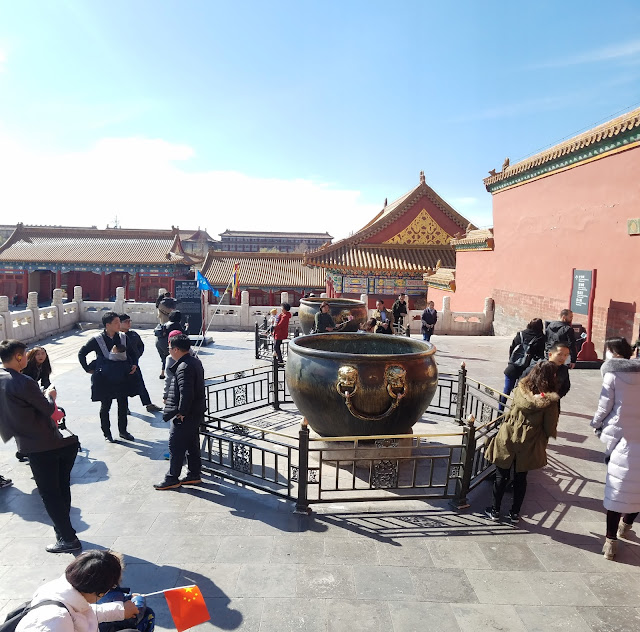The Forbidden City.....Finally!!!
 |
| Me, Martin, Pati, Valeria and Andrea after passing through inspection. |
So I hope I have done justice these pictures as I take you on my trip to the Forbidden City Palace.
You're probably are wondering,
"Why is it called the Forbidden City?"
Well, that's because back in ancient China, only the Emperor and all of his court people could live in the Palace, and because of this, no one, I mean,
NO ONE,
could leave nor enter without his permission.
If they did, you would be severely punished. More than likely with your life.
Anyways...
 |
| Meridan Gate before the Gate of Supreme Harmony |
The Meridan Gate, or the main entrance to the Forbidden City is the South side. This gate was mainly reserved for the use of the Emperor. Gongs and bells would have been ringing at every imperial coming and going. Lesser mortals would use different entrances. From the Meridan Gate it's a long way till you get to the be inside the palace since you enter an enormous courtyard and then cross the Golden Steam bridge. Once in front you reach the Gate of Supreme Harmony you are surrounded by another massive courtyard.
 |
| The Meridan Gate once you pass through it to the other side |
 |
| Courtyard of the Gate of Supreme Harmony |
 |
| 1918 Assembly for Emperor Puyi |
Back in the day this court yard could hold and imperial audience of around 100,000 people.
 |
| Gate of Supreme Harmony |
 |
| Courtyard of Gate of Supreme Harmony The building in the center is the Meridan Gate. |
 |
| Ceiling of Gate of Supreme Harmony |
 |
| Courtyard view of the Gate of Supreme Harmony |
 |
| The roof of the Hall of Supreme Harmony |
The Hall of Supreme Harmony itself is know to be one of the biggest structure in the Forbidden City and also the heart of the city. Built in the 15th century, it was used for ceremonial occasions such as the Emperor's birthday, or nominations of military leaders, or coronations.
 |
| Dragon Throne inside the Hall of Supreme Harmony. The carpet is an original and no one can go inside for its preservation. |
 |
| Inside of ceiling of Hall of Supreme Harmony |
 |
| The doors of the Hall of Supreme Harmony are made of gold and are very heavy. |
Literally.
His entire court had to have their foreheads touch the floor nine times in the emperor's presence.
the heart of the forbidden city.
 |
| The imperial dragon is at the tail of the procession which is led by a figure riding a phoenix followed by a number of mystical beast. The more beast, the more important the building. |

Funny enough, the last emperor, Emperor Puyi, used an altered bicycle (given to him by a Scottish tutor) to use around the Palace grounds, which I'm sure was way easier that gold plated fancy throne chair sedan thingamajig that servants had to carry.
 |
| Two carved dragons that weighs 250 tons and was dragged to Beijing on ice. |
 |
| The back wall of the Hall of Preserving Harmony. Notice the steps? That was to help the eunuchs carry the emperor down in his carrige and in the center is the marble with 2 dragons on it. |
Then there is the Palace of Earthly Tranquility which used to be the imperial couple's bridal chamber and the center of operations for the emperor's harem.
I did have a chance to see the Complete Palace of Peace and Longevity (I swear these names are ridiculous) which used to be where the dowager empress lived along with the imperial concubines (separately of course) back in the Ming Dynasty. Now, it was replaced with the Treasure Gallery.
Then there is the exit on the North Gate before you exit, you pass through the Imperial Garden which was interesting to say the least, and I can only image what it would look like without the amount of people that were there. The ancient cypress trees and the pretty pavilions are still there from their original state and were going through to slight cosmetic furnishing.
By the end of the day I was exhausted. The only slight relief I got was when we got to the North Gate exit and saw the towers of Jinshang Park.
As always, Zai Jian!
 |
| These massive vats can be found all around the city and were supposed to prevent fires. During the winter, these vats would be covered in thick woolen blankets so they would not freeze over. |
 |
| These dragon heads are ancient drainage tubes that let the water run out when it rains. |
 |
| Can't remember the long name for this building other than it was important as you can see with the amount of animals on the roof tops. |
 |
| The Exit of the Imperial Gardens to the North Gate Exit. |
 |
| Some of these dragon head door knobs are accented on the outside of doors. |
 |
| This tree is over 1000 years old! (So they say) |
 |
| This is the heart of the Imperial Gardens. |
 |
| This house was made for the emperor and within their garden when they wanted to be alone or read. It was also here that Emperor Puyi was tutored by his Scottish tutor, Sir Reginald Johnson. |















Thank you for allowing us to travel with you to these extraordinary places. And thanks for all the background information, it's well worth it. The sky is so blue on the pictures, is it blue in reality? xo
ReplyDelete